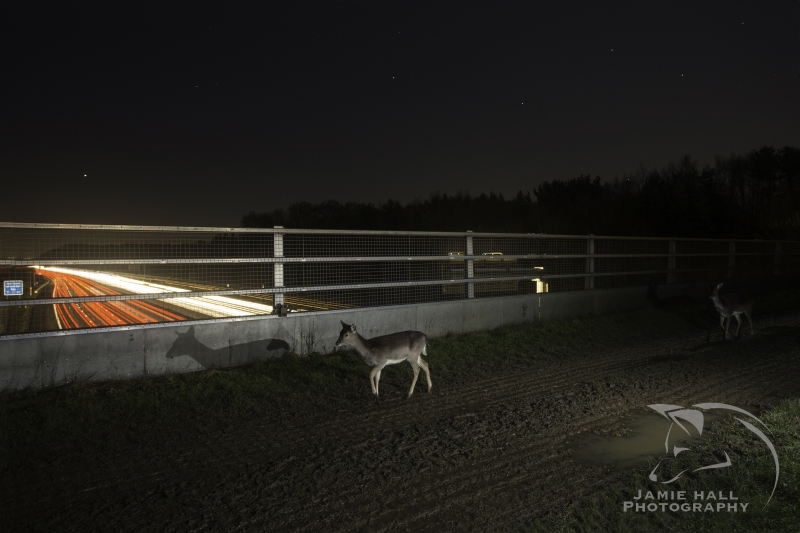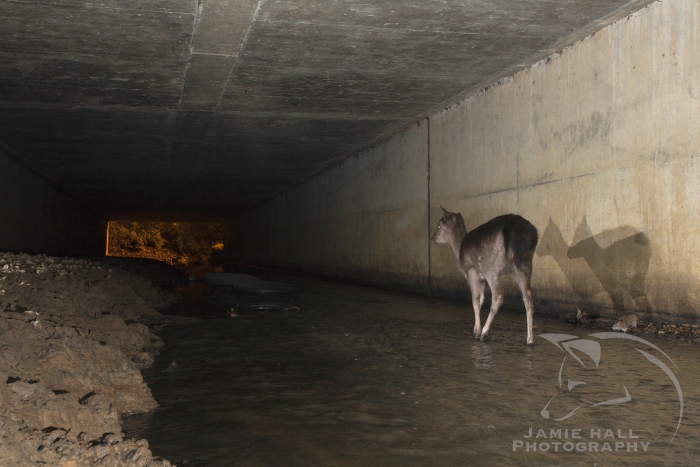Despite our ever-increasing human population, expanding road networks and urban sprawl, deer have adapted to living within major cities including the like of Sheffield, Edinburgh, and Southampton. Even more surprising is the number of deer that now inhabit London Boroughs inside the M25 orbital motorway- one of Europe’s busiest roads. How they manage to
 avoid the dangers of often eight-lane wide carriageways is an intriguing question. The sad fact is that vast numbers of deer die attempting to cross Britain’s roads leading approximately to 70,000 deer casualties, many hundreds of human injuries and several fatal traffic collisions every year. On just the M25 alone these annual figures include 65 deer road kills, however from our emerging research we now know that many more do manage to cross safely by using low underpasses and bridges. First evidence of this I captured on video using CCTV ten years ago, of one fallow buck crossing a narrow concrete M25 bridge. Some years later I managed to film also larger groups of deer crossing a wider bridge, but just one using a small underpass (see Youtube playlist below).
avoid the dangers of often eight-lane wide carriageways is an intriguing question. The sad fact is that vast numbers of deer die attempting to cross Britain’s roads leading approximately to 70,000 deer casualties, many hundreds of human injuries and several fatal traffic collisions every year. On just the M25 alone these annual figures include 65 deer road kills, however from our emerging research we now know that many more do manage to cross safely by using low underpasses and bridges. First evidence of this I captured on video using CCTV ten years ago, of one fallow buck crossing a narrow concrete M25 bridge. Some years later I managed to film also larger groups of deer crossing a wider bridge, but just one using a small underpass (see Youtube playlist below).
In attempt to record these novel behaviours in greater photographic quality and thus help demonstrate the value of such structures for both animal and road safety, I recently teamed up with wildlife photographer Jamie Hall – to make use of his innovative camera trap expertise – with quite astonishing results.

Jamie staked out some of the bridges I’d previously observed over several nights, producing stunning images that capture the calm nature in which deer cross a motorway bridge overlooking the busy night-time traffic. Amazingly, Jamie has now also been able to film deer passing through a number of long M25 underpasses, of which some preliminary photos and videos are being shown on these blog pages for the first time. Recent research with other colleagues has shown that fallow, red and roe deer do regularly use the small and mostly short underpasses (up to 35m in length) beneath local roads in the New Forest (Muttock, Langbein & Diaz, in prep). The even more surprising aspect shown so clearly here for the first time in Jamie’s images, is that fallow will regularly use much longer underpasses, including some less than 3 m high and over 100 meters long. Furthermore, the footage illustrates that deer will cross these low dark structures even when they are partially flooded.

In previous research (Existing Structure study) with The Deer Initiative I’d explored the potential suitability for use by deer of numerous bridges, underpasses and culverts over and under trunk roads in Devon and Cornwall. The findings highlighted that a high proportion of existing structures of quite modest size are likely to be adopted as safer crossings by deer, given limited modifications such as short lead-in deer fencing or even merely removal of various obstacles to their direct access. High deer fencing remains one of the few well proven methods of reducing deer collisions on motorways and major trunk roads, but even this tends to be most successful where it channels animals to safer crossing points. Wide “green bridges” or landscape bridges constructed in parts of Europe and the US primarily to reduce habitat fragmentation can help also to reduce animal collisions, but their high cost tends to rule them out from widespread use for deer-vehicle collision mitigation. To some extent the recent focus on high profile green bridge projects has led to a widespread misconception that much smaller or joint use structures, such as culverts, footpath and farm accommodation structures even when carrying low levels of road traffic, have limited potential as safer crossings for deer and other large wildlife species. As the images on these pages show so very clearly, deer are however are becoming increasingly accustomed to living close to traffic and urban areas, and do use many structures of modest size not specifically constructed for wildlife.
We now hope to raise sufficient funds to allow us to extend this work to study and film deer at several other motorways and trunk roads (using both trail-cams to record detailed wildlife movement activity patterns, as well as recording higher quality footage to help demonstrate the usefulness of wildlife passages to a wider public). This will help us determine the most successful structure types and local conditions to facilitate use by deer, and which type of existing structures under and over trunk roads have greatest potential to be adapted to maximise their usefulness for prevention of animal collisions.






I’ll tell you a story about the M25 crossing. Is it the one near Waltham Abbey?…. the chap involved is almost certainly deceased by now. I used to work in Epping Forest in the 1980s. When the M25 was constructed the Conservators were very worried that the burgeoning Fallow Deer popn. on the Copped Hall Estate outside the motorway would never be able to colonize the Forest closer to London. Some of the bridges were constructed as wildlife crossing points although not with the same degree of finesse of more modern ‘green’ bridges and wildlife corridors.
Months passed after the bridge was created and there were no signs of the deer wanting to use it. Worried, they asked George Matthews (?? – I think that was his name. He was a gamekeeper at Copped Hall). He took a bucket. Went to the deer sanctuary in Loughton and filled it with Fallow Deer dung which he then strewed along the bridge and in the areas either side of the bridge. Within a week the deer were moving back and forth with no problems.
Really good to hear more about the history of those near Epping and Copped Hall keeper. That narrow concrete bridge – also used by access vehicles – was the first place I filmed a buck crossing ten years ago (3rd of my youtube clips in playlist). I knew Donald Chapman (one of main fallow deer biologist at the time) who when M25 was about to be built argued at special committee in Parliament on behalf of the deer that bridges and a “cerviduct” tunnel should be built to ensure deer could cross. That’s not the same tunnel as now filmed with Jamie at other regions of M25 but shows deer will over time get used to all sorts of structures if can approach in good cover and left quiet at least part of the day.
In the 1970s as a child, I remember reading in the Guardian that there was talk of building new stretches of the M25 through the countryside as elevated motorway to enable deer to roam freely. I do not know how seriously it was considered. Building it as elevated motorway would make it more intrusive visually and noisewise, and it would have been very expensive. But it was an interesting idea.
Indeed , I believe this was considered. I assume you may have commented here after seeing the ‘Wild of the motorway’ TV program on BBC 4 evening of 30June2020? In that program it shows some sections especially on west sections where there are several main waterways, where the M25 was built elevated even though terrrain was less than ideal. It would have been awmazing to see most of it built elevated but clearly would have meant huge expenditure then but also for maintenance in future years. For deer movements Epping is relatively well served as there are two bridges, which at least after many years the deer now use, as well as using the small dia. cerviduct; but also can cross the wide landbridge at Bell Common, where the M25 goes through a long tunnel. While deer have also become used to crossing through some culverts further east along the M25, many part of the motorway are far less well served, and as a consequence in excess of 70 deer casualties are ‘recorded’ annualy along the M25, with many more no douby not recorded.